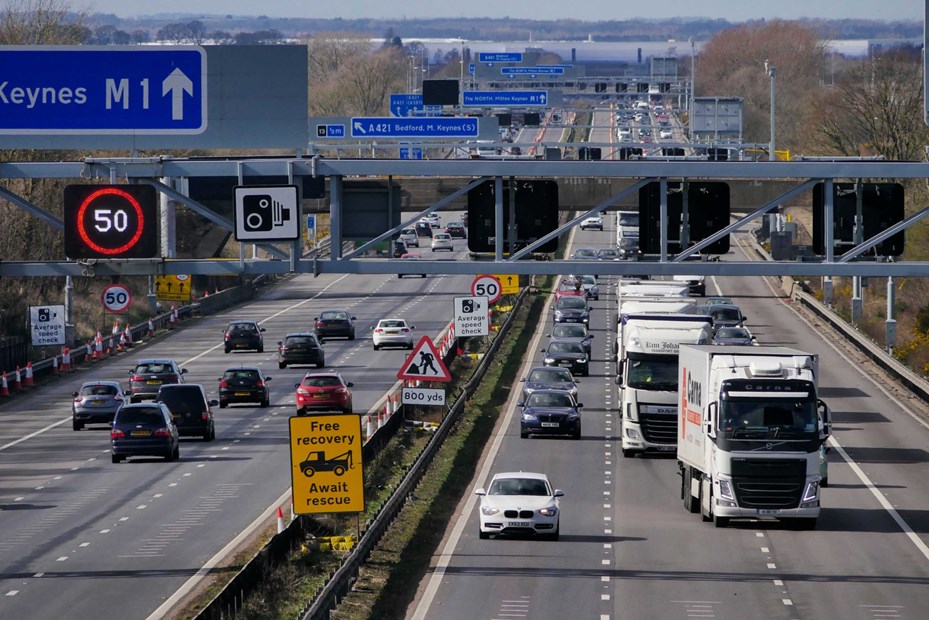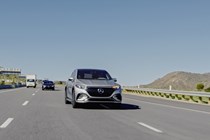Lane-keeping assist is an advanced driver assistance system (ADAS) that stops a car wandering beyond either side of the white lines that delineate a road lane. When the system is triggered, it nudges the car back towards the centre of the lane. In so doing, lane-keeping assist helps reduce the number of side swipe, head-on and run-off-road accidents.
The vast majority of news cars sold in the UK are fitted with lane-keeping assist as standard, and it’s found on a great many used cars, as well. If you’ve never experienced it before, it can be a bit disconcerting when you first feel the system intervene. But it can also serve to refocus your attention if you’re a bit distracted or getting tired.
Here, we’re going to explain everything you need to know about lane-keeping assist, when it’s triggered and what it feels like when it is.
How does active lane-keeping technology work?
A small camera or sensor, usually mounted on the rear-view mirror, detects the white lines at the side of a road lane and monitors the car’s position between them. If the car gets too close to either line, the car autonomously applies a small amount of steering or the brakes to nudge itself back towards the centre of the lane.
Lane-keeping assist is linked to the car’s indicators so, if you’ve turned them on to overtake or change lanes on the motorway, the system won’t be triggered. That does mean, however, that you’ll have to get used to indicating when moving back across to the left-hand lane.
Not all lane-keeping assist systems are created equal
There are no universal standards for how lane-keeping assist works. You could get into half-a-dozen different cars and the lane-keeping systems would react differently in each one.
Some manufacturers are very conservative in how they set up their systems and it intervenes when you’re actually quite a long way from the white lines. And some systems are a bit severe in their intervention, steering the car back to the centre of the lane much more abruptly than a human driver would. Some systems can get a bit confused by faded white lines and roads with no lines, as well.
Lane-keeping assist can be triggered if you’re steering around something like a pothole at the side of the road. That can make taking evasive action trickier than it really should be. Steer against the intervention and you’ll feel quite a lot of resistance through the wheel. You can get past it relatively easily, though, so you can still control the car yourself.
The best lane-keeping assist systems feel perfectly natural, allowing a relatively large margin of error before intervening. And when they do, they steer the car gently and smoothly.
Can I turn lane-keeping assist off?
While lane-keeping assist can be really helpful for many drivers, it’s entirely understandable if you don’t like the idea that the car wrest control of the steering away from you. Fortunately, you can turn the system off.
How you do that varies between different cars. Some have a button on near the steering wheel, labelled with an image of a car between parallel white lines. In other cars you’ll have to dive into the vehicle or safety settings menu on the infotainment system.
Some manufacturers require you to turn the lane-keeping assist off every time you start the car, which can be a bit irritating if you make a lot of journeys in a day. In other cars, the system will ‘remember’ that you turned it off, at least for a few hours.

How is lane-keeping assist different to lane departure warning?
Lane-keeping assist and lane departure warning go together, but they do different jobs. As the name suggests, lane departure warning gives some sort of indication that the car is about to stray out of its lane. Depending on the car, you’ll see a warning light, hear an alert, or feel a vibration through the seat or steering wheel.
All cars that have lane-keeping assist also have lane departure warning; some just have the latter.
Is lane-keeping assist really necessary?
Lane-keeping assist is primarily designed to prevent side-swipe accidents on dual carriageways and motorways, head-on collisions on single carriageway roads, and run-off-road accidents. A study published in 2022 by the Society of Automotive Engineers found that lane-keeping assist reduced the rate of those kinds of accidents by 60%. As annoying as the tech can sometimes be, it’s undoubtedly highly effective.
What cars have lane-keeping assist?
Lane-keeping assist has been mandatory on the majority of new cars sold in the UK and EU since 2022. You’ll find it on the Dacia Jogger, the Rolls-Royce Cullinan, and pretty much everything in between. It was becoming increasingly common before then, so there are vast numbers of older, used cars fitted with it, as well.
Fortunately, manufacturers tend not to give the system some opaque brand name, as they often do with other safety features, so you can easily work out from the car’s specs whether or not it’s fitted.







